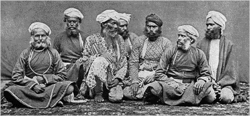1902 Encyclopedia > Thugs
Thugs
THUGS. That the Sanskrit root sthag (Pali, thak), "to cover," "to conceal," was mainly applied to fraudulent concealment, appears from the noun sthaga, "a cheat, has retained this signification in the modern vernaculars, in all of which it has assumed the form thag (commonly written thug), with a specific meaning.

Group of Thugs (or Thugees)
(Photograph taken in 1863)
The Thugs were a well-organized confederacy of professional assassins, who in gangs of from 10 to 200 traveled in various guises through India, wormed themselves into the confidence of wayfarers of the wealthier class, and, when a favorable opportunity occurred, strangled them by throwing a handkerchief or noose round their necks, and then plundered and buried them. all this was done according to certain ancient and rigidly prescribed forms and after the performance of special religious rites, in which the consecration of the pick-axe and the sacrifice of sugar formed a prominent part.
From their using the noose as an instrument of murder they were also frequently called Phansigars, or "noose-operators."
Though they themselves trace their origin to seven Mohammendan tribes, Hindus appear to have been associated with them at an early period; at any rater, their religious creed and practices as staunch worshippers of Devi (Kali, Durga), the Hindu goddess of destruction, had certainly no flavor of Islam in them. Assassination for gain was with them a religious duty, and was considered a holy and honorable profession. They had, in fact, no idea of doing wrong, and their moral feelings did not come into play.
The will of the goddess by whose command and in whose honour they followed their calling was revealed to them through a very complicated system of omens. In obedience to these they often traveled hundreds of miles in company with, or in the wake of, their intended victims before a safe opportunity presented itself for executing their design; and, when the deed was done, rites were performed in honor of that tutelary deity, and a goodly portion of the spoil was set apart for her.
The fraternity possessed also a jargon of their own (Ramasi), as well as certain signs by which its members recognized each other in the remotest parts of India. Even those who from age or infirmities could no longer take an active part in the operations continued to aid the cause as watchers, spies, or dressers of food.
It was owing to their thorough organization, the secrecy and security with which they went to work, but chiefly to the religious garb in which they shrouded their murders, that they could, unmolested by Hindu or Mohammedan rulers, recognized as a regular profession and paying taxes as such, continue for centuries to practice their craft. Both the fractions into which they were divided by the Nerbudda river laid claim to antiquity: while the northern, however, did not trace their origin farther back than the period of the early Mohammedan kings of Delhi, the southern fraction not only claimed an earlier and purer descent, but adhered also the greater strictness to the rules of their profession.
The earliest authenticated mention of the Thugs is found in the following passage of Ziau-d din Barni’s History of Firoz Shah (written about 1356): "In the reign of that sultan," that is, about 1290, "some Thugs were taken in Delhi, and a man belonging to that fraternity was the means of about a thousand being captured. But not one of these did the sultan have killed. He gave orders for them to be put into boats and to be conveyed into the lower country, to the neighborhood of Lakhanuti, where they were to be set free. The Thugs would thus have to dwell about Lakhnauti, and would not trouble the neighborhood of Delhi any more" (Sir H.M. Elliot’s History of India, vol. iii p. 141).
The first European travellers who speak of them without mentioning their name are Thevenot (1665) and Fryer (1673).

General Sir W.H. Sleeman, K.C.B. (1788 - 1856),
the British officer whose relentless campaign eliminated the Thug menace
Though instances of Thugee had been known to the English rulers in India for many years, and sporadic efforts had been made by them towards the extinction of the gangs, it was not till Lord W. Bentinck (1828-35) took vigorous steps in this matter that the system was gradually unmasked, and finally all but stamped out. His chief agent, Captain (afterwards Sir William) Sleeman, with several competent assistants, and the co-operation of a number of native states, succeeded in completely grappling with the evil, so that 1562 Thugs had been committed, of which number 382 were hanged and 986 transported or imprisoned for life. It is true that, according to the Thuggee and Dacoity Report for 1879, the number of registered Punjabi and Hindustani Thugs then still amounted to 344. But all of these had already been registered as such before 1852. It may, therefore, fairly be assumed that none are alive now, and that the whole fraternity may be considered as extinct.
Full particulars concerning the system, or Thuggee, are given by Dr Sherwood, "On the Murderers called Phansigars," and J. Shakespear, "Observations regarding Bradheks and Thegs" (both treatises in vol. xiii., 1820, of the Asiatic Researches); W.N. Sleeman, Ramaseeana, or a Vocabulary of the Language used by the Thugs, with an Introduction and Appendix, Calcutta, 1836; the Edinburgh Review for Jan. 1837; E. Thornton, Illustrations of the History and Practices of the Thugs, London, 1837; Meadows Taylor, Confessions of a Thug, London, 1839; Major Sleeman, Report on the Depredations committed by the Thug Gangs, Calcutta, 1840; J. Hutton, Popular Account of the Thugs and Dacoits, London, 1857; Yule and Burnell, Glossary of Anglo-Indian Colloquial Words and Phrases, London, 1886, p. 696 sq. ( R.R.)
The above article was written by Reinhold Rost, C.I.E., LL.D., Ph.D.; Oriental Lecturer at St. Augustine's Missionary College, Canterbury, 1851-96; Secretary to the Royal Asiatic Society, 1863-69; Librarian at the India Office, 1869-93; author of Treatise on the Indian Sources of the Ancient Burmese Laws and Revision of Specimens of Sanskrit MSS. published by the Palaeographic Society.
|

